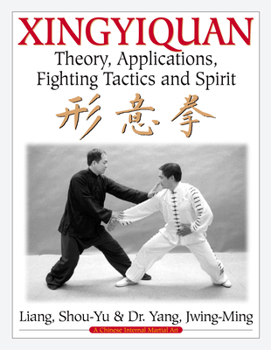Xingyiquan: Theory, Applications, Fighting Tactics and Spirit
Select Format
Select Condition 
Book Overview
Xingyiquan (Hsing I Chuan) is one of the best known Chinese internal martial arts. Xingyi means "Shape Mind", and Quan means "Fist" or "Style". The name derives from the style's imitation of the movements and inner characteristics of twelve animals. The style was created by Marshal Yeuh Fei, a famous general of the Chinese Song Dynasty. The practice of Xingyiquan, like Taijiquan, improves Qi circulation in the...
Format:Paperback
Language:English
ISBN:0940871416
ISBN13:9780940871410
Release Date:October 2002
Publisher:YMAA Publication Center
Length:302 Pages
Weight:1.35 lbs.
Dimensions:0.8" x 7.5" x 9.2"
Customer Reviews
4 ratings
Good learning book, emphasizes fundamentals
Published by Thriftbooks.com User , 16 years ago
I've been looking for a good book that explains Xing Yi, and I found it!!! It explains 5 elements (Pi, Beng, Zhuan, Pao, Heng) and 12 animals very clearly. Also, as a bonus, it shows the practical application of these movements!! It's definitely a good buy. Highly recommended.
Nice classics.
Published by Thriftbooks.com User , 19 years ago
The book is very good, especially because it has chinese characters, literary translation and commentary for all the classics it presents. It has however one issue: On page 237 of 2nd. edition 1st. print, Author writes: "Xing Yi Quan is sometimes called Xin Yi Quan because the heart plays such an important role." This is wrong. Xin Yi Quan is the older name from when the style had only 10 animals and was called Liu He Xin Yi Quan. Xing Yi Quan inherited the classics from that style, which is why it is spelled that way. He should read up on that and correct it for next print. I suggest he write a book with the classics of Xin Yi Quan, it has actually become a very popular style in Shanghai, China.
Very fine book on this still little understood art
Published by Thriftbooks.com User , 19 years ago
Here noted Chinese style expert Dr. Yang Jwing Ming has teamed up with Shou-Yu Liang, a noted martial arts coach, to produce an excellent volume on hsing-i (I prefer the older spelling). There's an awful lot of material here, including several chapters totaling 75 pages devoted to Chinese philosophy and medical theory. But if you're like me, you've read enough of that and will probably skip over that material and turn to the pages showing the pictures of all the postures, forms, and applications. While I respect the Chinese traditions and Chinese culture for creating these arts, I prefer western scientific explanations based on anatomy, neurophysiology, and kinesiology rather than the Chinese ones, which should be thought of as pre-scientific metaphors for later rigorous and more scientific analysis. For example, to give just one brief explanation without getting too technical, consider the neural reflex known as the reciprocal inhibition of flexor-extensor pairs. Such a pair would be the triceps and biceps muscles. This neural action speeds up the muscular response by reducing the opposing muscle's tension. When the internal arts such as Tai Chi and the others emphasize being soft and relaxed, this is one (among several) factors that if one is over-tense will be inhibited and will interfere with speed and overall agility. Although this reflex is not under voluntary control (being a spinal cord level reflex), overall muscle tension is controlled by an area of the brain known as the basal ganglia or telencephalic nuclei, a region of the brain just below the cerebral cortex. And this area of the brain does respond to voluntary control, and too heightened a state of mental anxiety, fear, and other factors can cause the basal ganglia to increase the level of muscle tension over what is optimal. This is one reason why the internal arts emphasize relaxation and not being too tense. But none of this was known until the last one hundred years. But getting back to the book, I liked the chapters showing the basic postures and moving patterns, the five-phases linking form, the Xing-Yi long form shown, and the chapter on practical applications. As the authors point out, after the student has learned the basic postures, the 12 shapes form is usually taught. But here the authors did something different which was nice. They presented another form instead which is rarely seen, a combination of the five fists and the 12 animal shapes that was developed by Master Liang's teacher, Master Zheng. The chapter also includes some of the applications of this interesting form. I think this is the main strength and most useful feature of the book, since the 12 shapes form can be found in several other books. In addition to the above, there is also a chapter on Xing-Yi Qi-Gong, an extensive appendix discussing Yue Fei's Ten Important Theses (the inventor of Xing-Yi), and a glossary of Chinese terms.
Including a discussion of xingyiquan theories
Published by Thriftbooks.com User , 21 years ago
Xingyiquan: Theory, Applications, Fighting Tactics And Spirit showcases one of the best known of the Chinese internal martial arts. Originated by Marshal Yeuh Fei (a famous general of the Chinese Song Dynasty), xingyi means "Shape Mind" and quan means "Fist" or "Style", and the marital arts combination called xingyiquan derives its name from an imitation of the movements and inner characteristics of twelve animals. Enhanced with two sequences with many of their martial applications, as well as the famous fight set "Ann Shenn Pau", Xingyiquan is a single volume, highly recommended instructional presentation of traditional xingyiquan training methods (including a discussion of xingyiquan theories and principles derived from many of the ancient poems and songs) which is ideal for martial arts students and practitioners at all levels of experience.




